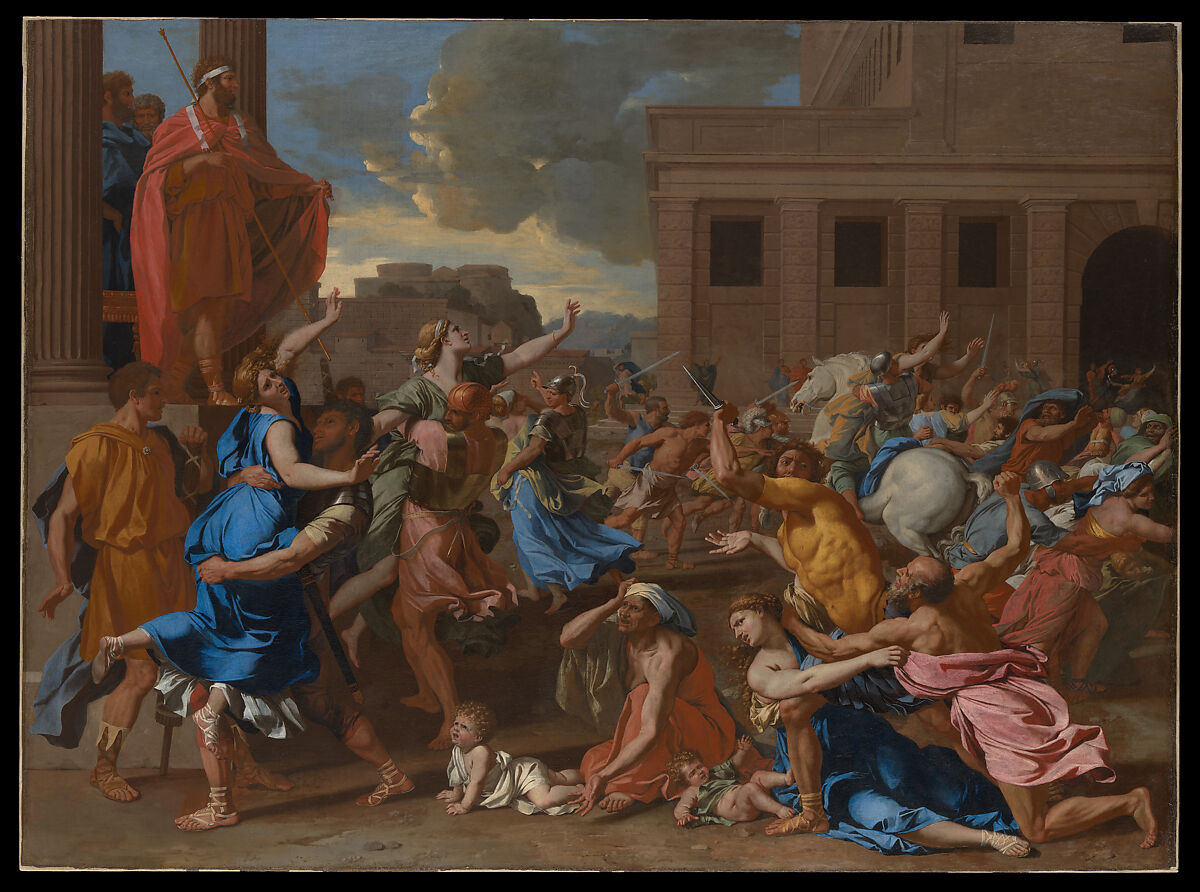The Abduction of The Sabine Women by Nicolas Poussin is a French oil on canvas painting finished 1634. The painting was created for Charles 1 de Crequy the marshal of the French army at the time. He was a prominent figure during the Thirty Years War and contributed greatly to the defeat of the Spanish Hapsburgs in the Piedmontese Campaign of 1624.
The Baroque influences of this painting are an evident from the high renaissance that had ended a century prior. The background of the painting is much more muted in color than a traditional renaissance painting. The use of these darker more muted colors was the intention of the artist to bring attention more so to the foreground of the painting in comparison to that of the bright detailed landscapes more commonly scene before the Baroque era. Another common theme of the Baroque era that can be seen in this painting is the theatrical positioning of each subject. Each person depicted is frozen in a state of movement that only appears it can be held for a brief second in time. The use of lines on the calf and thigh muscles portray the strain and energy propelling each subject into motion.
The realism of the painting is another important aspect of the Baroque influence on this piece. In Renaissance art before the Baroque era depictions of the Roman empire were dramatized and idealized to portray unrealistic depictions of historical events. In this painting we see realistic depiction of the chaos that would ensue. Shadowing is used on the faces of assailants in order to create a separation between them and their victims. The use of color is chosen meticulously. The use of royal blue and light green in the women's clothing conveys their innocence. The white horse portrays overwhelming strength of the invaders while the white on the child's cloak symbolizes survival or a hope for a beginning once the attack has ended.
These aspects have come together to create deep feelings of uncertainty and towards the balance of power. The perilous moment captured in this piece conveys the feelings of helplessness and impending destruction. With the knowledge of how this painting was created for the marshal of the French army during Thirty Years War it reveals the sentiment at the time. Uncertainty of the Catholic power France fighting on the side of the Protestants, the glory of the rise of Roman rule and the opportunity of France to become the next great power, and the risk of defeat and what it would mean for the people of France.
The Baroque art style is far superior in the depiction of the story it is able to convey in this painting when compared to the art styles used during the Renaissance. The goals of the counter-reformation and Council of Trent were to create less ambiguity amongst the Catholic faith and its followers. This was shown through its more realistic painting and sculptures like in The Abduction of The Sabine Women in order to convey a Catholic message to its followers.
For comparison this painting is Christ Healing the Blind by El Greco painted in 1570. Here the pre-Baroque Renaissance methods highlight the evidence of change between the two eras. The subjects faces are at rest and their bodies are unstrained. The background is vast, highlighted, and takes attention away from the foreground. The use of bright blue in the background color is a stark difference from the muted background colors used in the Baroque painting. Lastly it is important to mention the balance that is prevalent in Renaissance art. Both paintings have large crowds formed but in The Abduction of the Sabine Women we see a more random, natural, distribution of bodies and subjects. In Christ Healing the Blind we see three groups one lower middle group, and two elevated groups separated between left and right creating a balanced frame.Works Cited
Britannica, The Editors of Encyclopaedia. "Charles I de Blanchefort, marquis de Créquy". Encyclopedia Britannica, 13 Mar. 2024, https://www.britannica.com/biography/Charles-I-de-Blanchefort-marquis-de-Crequy. Accessed 10 October 2024.
Christ Healing the Blind. The Met Museum, New York
https://www.metmuseum.org/art/collection/search/436572 Accessed 10 October 2024
The Abduction of The Sabine Women. The Met Museum, New York
https://www.metmuseum.org/art/collection/search/437329 Accessed 8 October 2024.






Your comparison of paintings in the Renaissance and the Baroque Era was wonderful. I could clearly see the differences between the two paintings you showed, and how they represent themselves-balanced vs harmonized flow. Both are easy to follow with eyes throughout the works. I like how you pointed out the colors of the robes of the women and children and what they represent. The colors specified to just them, also makes it easy to find them throughout the painting. The uncertainty can be felt dripping off the canvas like wet paint. Especially as you zero in on the children's faces looking up towards their mothers and the scene unfolding before their eyes. It leaves you questioning, what does the future look like for these children?
ReplyDelete